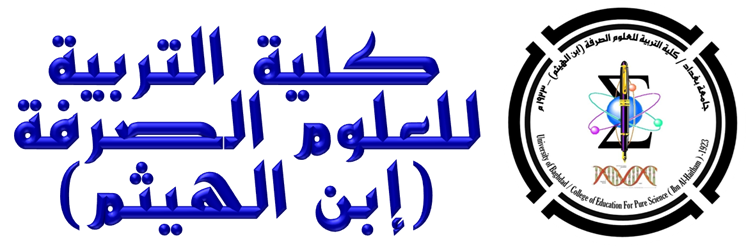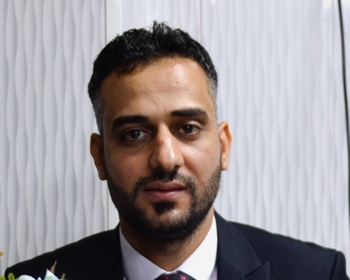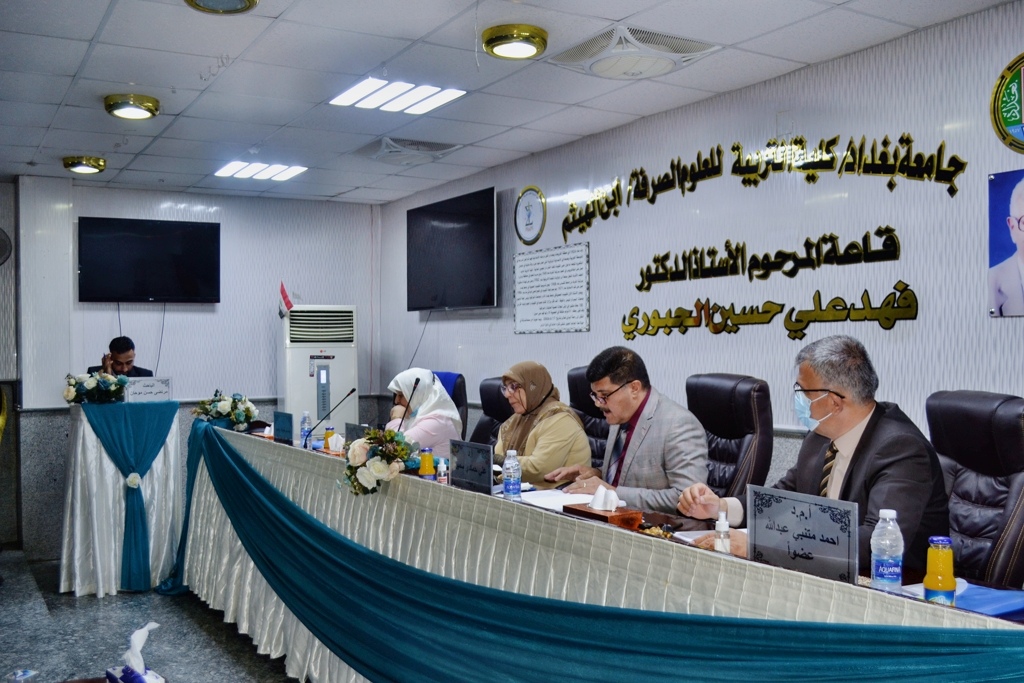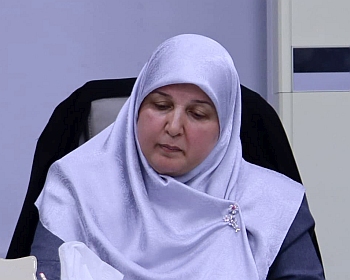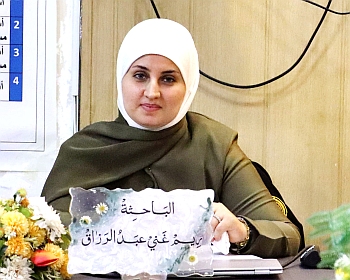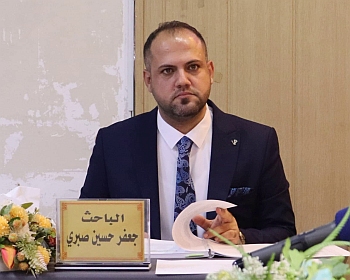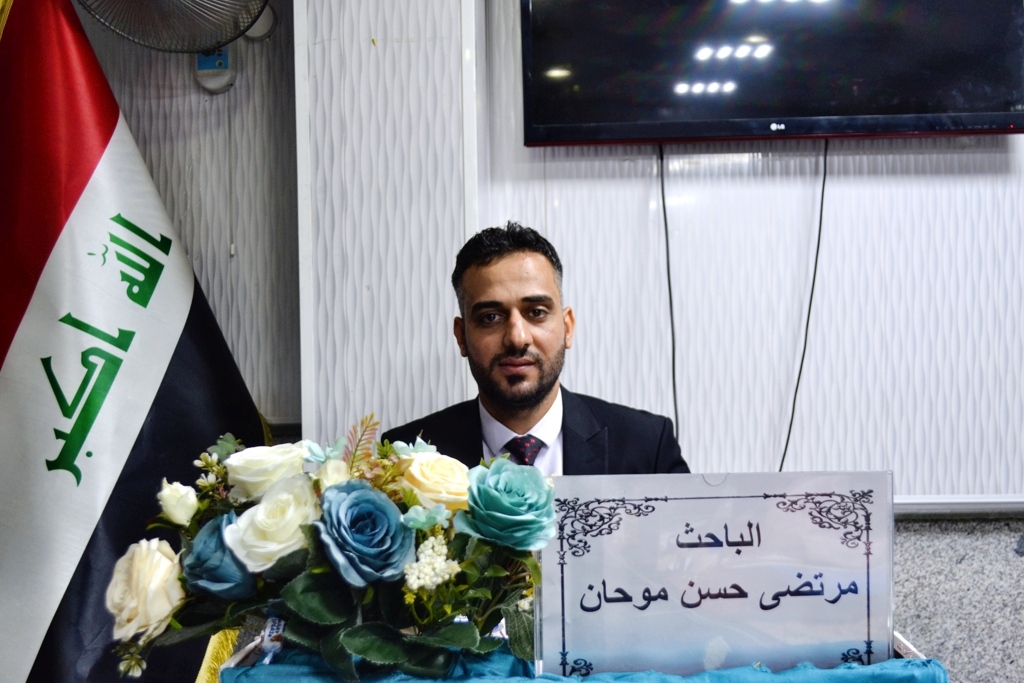 ناقش قسم الكيمياء في كلية التربية للعلوم الصرفة (ابن الهيثم) رسالة الماجستير الموسومة (تحضير وتشخيص والتقييم المضاد للبكتريا لبعض المركبات الحلقية غير المتجانسة المتضمنة الحلقات الرباعية و الخماسية و السداسية والسباعية مبتدأ من الايبوبروفين) للطالب (مرتضى حسن موحان خضير) التي انجزها تحت اشراف التدريسية في القسم (أ.د. ابتسام خليفة جاسم) ونوقشت من قبل أعضاء لجنة المناقشة المبينة أسمائهم فيما يأتي :
ناقش قسم الكيمياء في كلية التربية للعلوم الصرفة (ابن الهيثم) رسالة الماجستير الموسومة (تحضير وتشخيص والتقييم المضاد للبكتريا لبعض المركبات الحلقية غير المتجانسة المتضمنة الحلقات الرباعية و الخماسية و السداسية والسباعية مبتدأ من الايبوبروفين) للطالب (مرتضى حسن موحان خضير) التي انجزها تحت اشراف التدريسية في القسم (أ.د. ابتسام خليفة جاسم) ونوقشت من قبل أعضاء لجنة المناقشة المبينة أسمائهم فيما يأتي :
-
أ.د. علي حمادي سمير ( رئيسا )
-
أ.م.د. ايمان محمد حسين ( عضوا )
-
أ.م.د. احمد متنبي عبد الله (عضوا )
-
أ.د. ابتسام خليفة جاسم ( عضوا ومشرفا)
تضمن البحث تحضير أربع ، وخمسة ، وستة ، وسبعة حلقات عضوية من المركبات الحلقية غير المتجانسة ودراسة النشاط البيولوجي. وتشمل هذه المركبات البيرازول ، والأوكسيدازول ، والثيازول ، والتريازول ، والأوكسازول ، والبيريدازين ابتداءً من الإيبوبروفين (2- (4-إيزوبوتيل فينيل) حمض البروبانويك).
يتكون هذا البحث من تحضير مركبات حلقية غير متجانسة من أربعة وخمسة وستة إلى سبعة حلقات بدءًا من الإيبوبروفين.
يتضمن هذا البحث ستة أجزاء مختلفة كما هو موضح أدناه:
الجزء 1: تضمن هذا الجزء تخليق مشتقات البيرازول [4] ، الفثالازين -3،8-دايون [5] والبيريدازين -3،6 دايون [6] المشتق من مركب هيدرازيد [3]. كما هو موضح في المخطط الأول.
الجزء الثاني: تضمن هذا الجزء تخليق أوكسازول [8] ومشتق الثيازول [10] من خلال تفاعل 2- (4-إيزوبوتيل فينيل) بنتان مع اليوريا والثايوريا وتخليق المركبات الناتجة باستخدام بارا فنيل فينسايل برومايد ، كما هو مبين في المخطط الثاني.
الجزء الثالث: تضمن هذا الجزء تخليق ثياديازول ، تريازول ، ثيازوليدين وأوكساديازين عبر تفاعل مركب هيدرازيد [3] مع إيزوثيوسيانات فينيل في الإيثانول المطلق ليعطي المشتق ] [11ومفاعلة الناتج مع حامض الكبريتيك ليعطي [12]و هيدروكسيد الصوديوم فيعطي المركب [13] ] و بارا فنيل فينسايل بروميد ليعطي الناتج[14]، وتفاعل مركب هيدرازيد [3] مع حمض الكلورو أسيتيك وخلات الصوديوم يعطي الناتج [15] كما هو موضح في المخطط الثالث.
الجزء الرابع: تضمن هذا الجزء معالجة مركب هيدرازيد المتفاعل [3] مع 4—ثنائي مثيل امينو بنزالدهايد و 4- نايترو بنزالديهايد و 4 هيدروكسي بنزالديهايد للحصول على قواعد شيف [16،17،18]. ثم مفاعلة المشتق [16] مع أنهيدريد الماليك ، أنهيدريد الفثاليك و 3-نتروفثاليك أنهيدريد للحصول على مشتقات الاوكسازيبين [19-21] ومع أزيد الصوديوم للحصول على مشتقات تترازول [22] ، كما هو موضح في المخطط الرابع.
الجزء الخامس: ويتضمن تحضير مركبات الحلقة الرباعية [23-24-25] من المركبات] 16,17,18] على التوالي مع وجود ثلاثي إيثيل أمين وكلوريد أسيتيل كلورايد. كما هو موضح في المخطط الخامس.
الجزء السادس: ويتضمن دراسة الأنشطة المضادة للبكتيريا لبعض المركبات المحضرة. تم تحديد هذه الأنشطة في المختبر باستخدام نهج انتشار البؤر ضد 3 أنواع من السلالات المسببة للأمراض من البكتيريا ، وهي بكترياالقولون ، الزائفة (G-) ، والمكورات العنقودية الذهبية (G +).حيث أظهرت النتائج التي تم الحصول عليها أنشطة قابلة للقياس
وخلص الطالب في نهاية رسالته الى التوصيات الاتية :
-
الدراسة الصيدلانية للمركبات المحضرة في الجسم الحي.
-
دراسة سمية المركبات المحضرة.
-
دراسة الخصائص البلورية السائلة للمنتجات الجديدة.
-
دراسة خصائص مضادات الأكسدة.
-
دراسة موصلية المركبات المحضرة.
-
دراسة الطفرات البوليمرية للمركبات المحضرة.
-
دراسة بصرية المركبات المحضرة.
Synthesis,Characterization and Antibacterial Evaluation of Some New Heterocyclic Compounds Including Fourth, Fifth, Sixth and Seventh Membered Ring Start From Ibuprofen
By Murtadha Hassan Mohan
Supervised by prof.Dr.Ibtisam Khalifa Jassim
The aim of work
The research includes the preparations of four, five, six and seven ring organic from heterocyclic compounds and studying the biological activity. These compounds including pyrazole, oxidazole, thiazole, triazole, oxazole and pyridazine starting from ibuprofen (2- (4-isobutylphenyl) propanoic acid)
Abstract
This work consisted of preparing heterocyclic compounds of four, five, and six to seven rings starting with ibuprofen
This work includes six different parts as shown below
First part: This part included the synthesis of pyridazine derivatives [4], phthalazine -3,8-dione [5] and pyridazine -3,6 dione [6] derived from the compound hydrazide [3]. as shown in scheme I
Second Part: This part involved the synthesis of oxazole [8] and thiazole derivative [10] via the reaction of 2-(4-isobutyl phenyl) pentan-3-one with urea and thiourea and cyclization of the resulted products with p-phenyl phenacyl bromide, as shown in Scheme II.
Third Part: This part involved the synthesis of thiadiazole, triazole, thiazolidin andoxadiazin via the reaction of hydrazide compound [3] with phenyl isothiocyanate in absolute ethanol and gave [11] and cyclization of the products with sulfuric acid gave [12], Sodium hydroxide gave [13] and with p-phenyl phenacyl bromide to give to produce[14], reaction of hydrazide compound [3] with chloroacetic acid and sodium acetate gave the derivative [15] as shown in Scheme III.
Fourth Part: This part involved treatment of reacted Hydrazide Compound [3] with 4-N.N-dimethyl amino benzaldehyde, 4-nitro benzaldehyde and 4-hydroxy benzaldehyde to get Schiff bases [16,17,18]. Then cyclization the products with maleic anhydride , phthalic anhydride and 3-nitrophthalic anhydride to get oxazepines rings [19-21] and with sodium azide to get tetrazole rings [22], as shown in scheme IV
Fifth Part: It includes the preparation of the Quaternary ring compounds [23-24,25] from the compounds [16,17,18] respectively with the presence of triethylamine and chloroacetylchloride. as shown in Scheme V
Sixth Part: which includes the study of the antibacterial activities for some synthesized compounds. Those activities have been specified in vitro with the use of the approach of the well diffusion against 3 types of the pathogenic strains of the bacteria, which are E.coli, Pseudomonas (G-), and staphylococcus aureus (G+) The results that have been obtained exhibited measurable activities, which is seen in Table 3-6
-
Recommendations
Pharmaceutical study of the synthesized compounds in vivo
Study the toxicity of the synthesized compounds
Study the liquid crystalline properties for the new products
Study the antioxidants properties
Study the conductivity of the synthesized compounds
Study the of Mutations polymeric of the synthesized compounds
Study the optical of the synthesized compounds
-
